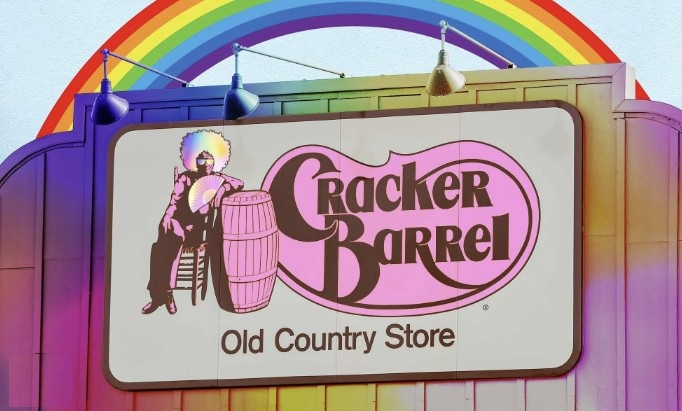The following article, Cracker Barrel, DEI, and the Price of Ignoring Wisdom, was first published on The Black Sphere.
Cracker Barrel is more than a restaurant chain. It’s a cultural touchstone—an Americana relic that thrives on nostalgia. Families don’t go there because it looks like a WeWork or has sleek Scandinavian furniture. They go for rocking chairs on the porch, fireplaces in the dining room, and the illusion of stepping back into a simpler time. The brand lives and dies on that very identity.
Which is why the company’s recent missteps aren’t just strategic errors—they’re existential ones.
When new CEO Julie Masino greenlit a redesign of the logo and launched an ambitious $700 million modernization plan, investors recoiled. The “update” wasn’t merely about aesthetics; it represented a failure to understand the DNA of the business. Worse still, the plan brought with it no demonstrable path to new revenue. It was change for change’s sake, underpinned by the same cultural forces that have been suffocating American businesses for the past decade: Diversity, Equity, and Inclusion (DEI).
The Latency of DEI
The problem with DEI isn’t always immediate. It creeps in slowly, in boardrooms and executive suites, under the guise of progress. At first, it looks harmless—like a harmless training, a new department, or a rebranding campaign. But the latency of DEI is what makes it so insidious. Over time, it shifts priorities, distorts incentives, and builds an internal culture where telling the truth is dangerous.
Consider the sheer absurdity: Masino’s redesign was supposed to attract “modern customers.” But what does that even mean for a brand like Cracker Barrel? The core customer doesn’t want modern. They want memory. DEI-era logic, however, conditions leaders to chase approval from the loudest cultural critics, not the most loyal customers. That’s why strategy starts to look like self-sabotage.
This isn’t theory—it’s quantifiable. Cracker Barrel’s logo redesign triggered a firestorm of backlash that wiped millions from its market cap. Market value isn’t just about numbers; it’s a barometer of trust. And trust evaporates when leadership appears more interested in virtue than value.
Biglari Saw It Coming
Enter Sardar Biglari, the company’s largest shareholder. Biglari warned the board last year that DEI-driven rebranding was “obvious folly.” Fox Business chronicled how his cautions went unheeded. He wasn’t merely nitpicking design; he was diagnosing the cultural disease spreading through the company.
Today, Biglari is calling for Masino’s removal. And it’s not because of one ill-fated redesign. It’s because the company’s leadership, from board to C-suite, has become littered with individuals more committed to optics than outcomes.
Biglari understands what so many executives don’t: a company cannot survive when its leaders are distracted by identity politics instead of customer loyalty, cultural fit, and financial discipline.
DEI’s Corporate Toll
Cracker Barrel’s situation is hardly unique. After the death of George Floyd, corporate America poured billions into DEI initiatives—mistaking emotion for strategy. Walmart pledged $100 million for a racial equity center. Ford promised to re-engineer its hiring process. Cisco declared diversity “unarguable business value.”
And yet, the results? Walmart’s DEI center is fading into obscurity. Ford abandoned its Human Rights Campaign score. Harley-Davidson axed its DEI division. Cisco’s stock trailed the S&P 500 by nearly half over five years.
The verdict is in: DEI didn’t create value. It destroyed meritocracy, eroded trust, and left companies bloated with bureaucracies that rewarded noise over results.
A Better Model: One Mission, One Culture
At Unified Solutions of America, we believe the answer isn’t complicated: One Mission, One Culture.
What if everyone in an organization was genuinely focused on a single goal—so much so that all distinctions vanished? Not because people were forced to conform, but because the shared purpose made differences irrelevant. In such a place, the DNA of the company—the mission—becomes the culture.
That’s what drives innovation. That’s what builds success. That’s what fosters real inclusion.
Imagine a workplace where people aren’t hired to fill quotas, but to fill roles—where excellence is the only identity that matters. Race, gender, sexuality, background—none of it matters when everyone is rowing in the same direction.
That is true diversity: when people are free to bring their talent, their work ethic, and their ideas to a table that values results above all else.
Why This Matters for Cracker Barrel
Cracker Barrel doesn’t need a $700 million redesign. It doesn’t need a “new identity.” It doesn’t need DEI consultants whispering in executives’ ears. What it needs is alignment—mission over metrics, culture over quotas, outcomes over optics.
Biglari sees this. Investors see this. Even customers, whether they articulate it or not, feel this.
The lesson here is bigger than Cracker Barrel. It’s about the future of American business. Companies that cling to the failed experiment of DEI will stumble. Those that embrace unity of purpose will thrive.
At Unified Solutions of America, we’re here to help businesses make that transition. Not into something they’re not—but back into what they were always meant to be: unified, mission-driven, and unapologetically excellent.
Because in the end, nostalgia doesn’t just belong on Cracker Barrel’s walls. It belongs in its DNA. And if the company listens—not just to its customers, but to its largest shareholder—it may just find that the best way forward is to stop chasing the future, and start protecting the past.
Learn more at UnifiedSolutionsAmerica.com.
Continue reading Cracker Barrel, DEI, and the Price of Ignoring Wisdom …

